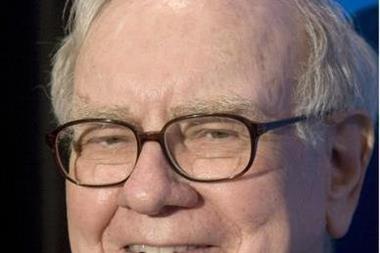Insurers lobbied furiously when the Walker Review, set up to look at bankers’ pay, called for public disclosure of all £1m-plus salaries. It is unfair, they said, to tar us with the same brush as bankers. Insurance Times sees if they’re right …
Public anger over bankers’ pay packets erupted when the financial storm broke in 2008. The government’s reaction was to commission the Walker Review to examine corporate governance in UK banking – and to extend its remit to identify other financial institutions in which its proposals could apply.
One recommendation that sent ripples throughout the general insurance industry was that it should reveal the number of employees receiving pay packets of more than £1m. Extensive lobbying – general insurers felt that it was unfair to tar them with the same brush as bankers – led to the proposal’s withdrawal. But as the media storm around bankers’ bonuses strengthens, Insurance Times has done some digging to see how the pay of top executives in insurance compares.
Unless the Walker recommendations are fully adopted, companies will continue only to be required to report full remuneration details of the board of directors – normally the group chief executive, chief financial officer, a small number of executive directors and non-executive directors – plus a high-level breakdown of staff costs for all employees. Since most insurance companies in the UK are foreign-owned, with relatively few UK-based representatives occupying the top positions, only limited information is available.
Comparative executive pay for 2008, the latest year for which figures are available in company annual reports, provides good insights into basic pay and bonus structures for some at the top table.
Basic pay in that year – before bonuses and benefits – was less than £1m for group chief executives of composite insurance companies.
By comparison, basic pay for the main UK high street bank group chief executives was more than £1m. Basic annual pay for chief executives of general commercial insurers and mutual insurers was between £400,000-£600,000, with most getting less than £500,000 (see table 1, in pdf attachment, right).
Lloyds Banking Group’s executive director for insurance Archie Kane earned a basic salary of more than £500,000 in 2008. But, with the rest of the Lloyds board, he turned down any bonus in the light of that year’s government rescue.
Nice little earner
While many bankers may not have received bonuses in 2008, many insurance executives did; although bonuses generally were below the £1m mark. Figures for 2007, when high street bankers last took bonuses, indicate that they got considerably more (see below ‘How does UK banking bosses’ remuneration compare?’).
While insurance executives get less in their pockets than bankers, their basic salaries and benefits (paid in full, regardless of company performance) means they are still very well paid.
So are their bonuses justified? And do they really have an impact on executive performance?
As bonuses are performance-related, it would not be unreasonable to expect to be able to easily relate them to public performance indicators for their companies, such as gross written premium (GWP), a measure of written business before reinsurance; combined operating ratio (COR), an indicator of underwriting profit; or earnings per share (EPS), an indicator of company profitability. Such comparisons make little sense, however, mainly because bonuses are designed to achieve both short and long-term goals. Table 2 (in pdf attachment, right) shows a comparison of chief executive remuneration against the performance of the company.
It is worth noting, however, that there were changes at the top in 2008, particularly in companies where reported general insurance COR exceeded 100% and/or EPS returns were poor relative to competitors.
Adrian Brown succeeded Bridget McIntyre at RSA, where combined ratio exceeded 100%, and Mark Hodges replaced Igal Mayer at Aviva, where COR and EPS were dismal. However, there has never been any public statement linking these two departures with company results.
Michael Rogers at LV=, a friendly society, did not seem to be penalised despite the poor combined ratio for his company and, in fact, he received a sizeable bonus. His bonus exceeded those paid to chief executives at Hiscox and Brit, even though these companies reported better combined ratios and higher GWP.
At publicly quoted companies, remuneration committees – sub-committees of main boards – create policies for deriving bonuses, both annual bonuses and long-term incentive bonus schemes (see below ‘More than cash’). It is clear that companies believe that bonuses, paid out as a mixture of cash and shares, are needed to motivate their executives and to keep them on board.
The way bonuses are awarded at mutual and friendly societies indicates that they are adopting the same habits as their publicly quoted competitors – not surprising, given that the same group of remuneration consultants advises both sectors. And since these consultants compare pay across companies, and no company wants to be seen to pay below average levels, this forces a continual upward momentum.
Small change
So, what of those Walker recommendations? Was it correct to bow to general insurance industry lobbyists and remove the requirement to state the numbers of executives earning more than £1m?
For now, it looks like the right decision, based on the publicly available information: bonuses are not excessive compared with bankers, and even basic pay, although substantial, has been exceeded by key executives in other industries – new Marks & Spencer boss Marc Bolland’s reported £8.5m first-year deal is just one example.
But wouldn’t it have been better for the public to have been offered more evidence so they could make their own judgments? After all, sunlight is the best disinfectant if something is rotten at the core. IT
How does UK banking bosses’ remuneration compare?
Like their insurance counterparts, total pay packets for the bosses of major UK high street banks are made up of basic pay (in excess of £1m is standard), benefits and two bonuses (annual to encourage the delivery of targets, as well as incentives to keep them in their jobs and to deliver longer-term goals).
While bankers appear to have been less well-paid than insurance bosses in 2008, 2007 tells a different story. Bonuses added to basic pay and benefits delivered total pay packets of more than £4m in the case of John Varley at Barclays and Sir Fred Goodwin at The Royal Bank of Scotland. Bosses at Lloyds and HSBC did less well, receiving £2.88m and £3.54m, respectively. However, the banking crisis has put the industry’s remuneration under the spotlight and changes are expected.
More than cash
Although the composition of board-level insurance executives’ pay packets vary, all have several features in common. Compensation is generally made up of basic pay, bonus payments and pension, plus other taxable benefits, such as car allowance, medical insurance, travel benefits and so on.
Most executives are awarded two bonuses: an annual sum to motivate them to achieve annual business plans and normally paid as a mixture of cash and shares, and incentives to reach longer-term goals and to encourage them to stay. Paid wholly as shares, the schemes generally last for three years, after which the shares will vest if targets have been achieved.
Some schemes require the executive to buy shares at a favourable discount, while others offer a portion of the shares at a nominal value. Bonus schemes come as ‘standard’ and ‘stretched’, to really test executive mettle.
Different criteria are used for annual bonuses and long-term incentives. Bonuses may be weighted to a variety of business criteria, such as operating profit, costs and/or combined operating ratio, as well as more intangible performance indicators, such as employee engagement and customer satisfaction benchmarks.
Targets based on return on equity and total shareholder return are often used for long-term incentive schemes.
Downloads
Insurer CEO pay tables
PDF, Size 0.1 mb
Hosted by comedian and actor Tom Allen, 34 Gold, 23 Silver and 22 Bronze awards were handed out across an amazing 34 categories recognising brilliance and innovation right across the breadth of UK general insurance.














































No comments yet